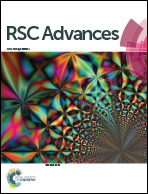Influence of the cathode microstructure on the stability of inverted planar perovskite solar cells†
Abstract
One of the main challenges for perovskite solar cells (PSC) is their environmental stability, as oxygen and water induced aging may result in mobile decomposition compounds, which can enhance the recombination rate and react with charge carrier extraction layers or the contact metallization. In this contribution the importance of the microstructure of the contact metallization on the environmental cell stability is investigated. For this purpose, the storage stability of inverted planar methylammonium lead iodide (MAPI)-based perovskite solar cells without encapsulation is tested, using the metals aluminum (Al), silver (Ag), gold (Au) and nickel (Ni) as representative cathode materials. For this study, scanning electron microscopy (SEM) and energy-dispersive X-ray spectroscopy (EDX) analysis of the different electrodes as well as the perovskite is correlated with PSC device current–voltage (J–V) and impedance measurements. Our findings substantiate that the metal microstructure has a significant influence on the PSC aging properties. While a strong perovskite decomposition and iodide diffusion to the contacts were detected for devices using Al, Ag or Au cathodes with a polycrystalline microstructure, these effects were strongly reduced when Ni metallization was employed, where a nanocrystalline microstructure was exhibited under the chosen process conditions.



 Please wait while we load your content...
Please wait while we load your content...